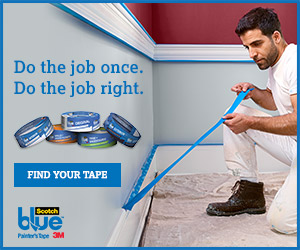 Joseph Bartusiak is 3M’s Senior Research Engineer in the company’s Construction and Home Improvement Markets Division. He regularly fields questions about painter’s tape performance and product development. Here, he shares some technical insights on how UV-resistant technology can impact a pro’s bottom line.
Joseph Bartusiak is 3M’s Senior Research Engineer in the company’s Construction and Home Improvement Markets Division. He regularly fields questions about painter’s tape performance and product development. Here, he shares some technical insights on how UV-resistant technology can impact a pro’s bottom line.
Q: Why is UV resistance important for painter’s tape, and how do manufacturers offer this protection?
A: Painter’s tape has a dual goal of needing to adhere well enough to help the painting professional cut a clean line while also being easy to remove without leaving behind a sticky residue that requires cleanup. Product engineers strike this balance by researching and applying knowledge to develop the right adhesive that will help achieve both of these outcomes.
Exposure to the sun’s harsh UV rays for a lengthy period of time may compromise the tape’s ability to adhere but, more importantly, it greatly increases the likelihood of the tape’s adhesive leaving a sticky residue on the surface. This is particularly problematic for glass, wood or vinyl, as the residue may be highly visible if not cleaned well. In addition, removing the residue adds time to the job, negatively impacting a painting professional’s bottom line.
How UV resistance helps
UV resistance comes into play for painting professionals in a variety of job situations. Think about those exterior jobs where delays force tape on the side of a home with strong sun exposure to stay adhered to the surface for more time than expected. Direct sun literally baking a tape that is not UV resistant will undoubtedly leave behind a residue that needs to be cleaned. This can also occur on interior jobs where a non-UV-resistant tape is used on a window with strong sun exposure.
If a tape is UV resistant, it means that its adhesive has been formulated to withstand direct sunlight and heat better and for a longer period of time. Quality UV-resistant tapes will indicate the length of time the product provides adequate adhesion and a promise of leaving behind no residue when pulled off. Typically, these claims range between seven and 14 days, depending on the product.
How a tape product can be UV resistant
People often ask how it is that a manufacturer can create a UV-resistant tape, as they associate the topic mainly with lotions and creams used to protect the skin. For tape, the secret to UV resistance lies in using an acrylic adhesive combined with other additives. These particular acrylic adhesives provide low adhesion build, which allows for a longer damage-free removal time.




